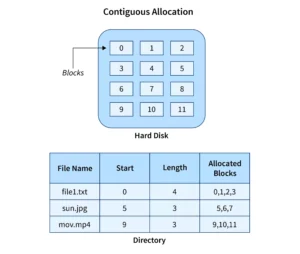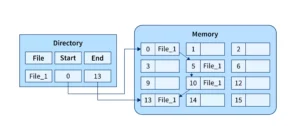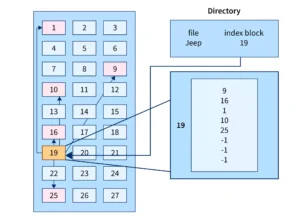File Allocation Methods
File allocation refers to how files are stored on a storage medium. When a file is saved, the operating system must decide where and how to place its data blocks on disk. This process affects file access speed, disk space usage, and overall system performance. The most common file allocation methods are Contiguous, Linked, and Indexed allocation.
Contiguous Allocation
In contiguous allocation, each file is stored in a single continuous block of space on the disk. Once a file’s size is known, the operating system finds a large enough sequence of empty blocks and assigns them to the file.
This method offers fast and direct access to data because the file can be read sequentially without seeking different locations. It also simplifies calculations for locating a specific block.

However, contiguous allocation suffers from a major limitation: external fragmentation. Over time, as files are created and deleted, large enough contiguous spaces become scarce. Another drawback is that the file’s size must be known in advance, making it less flexible for files that may grow.
Linked Allocation
Linked allocation stores each file as a linked list of disk blocks, which can be scattered throughout the disk. Each block contains not just data, but also a pointer to the next block in the sequence.
This method eliminates external fragmentation and is well-suited for files that grow over time, since blocks can be added wherever space is available. It’s also more flexible when handling variable file sizes.

The downside is that random access becomes inefficient. To access a specific block in the file, the system must follow the chain of pointers from the beginning. Additionally, if a pointer is lost or corrupted, it can result in broken file chains.
Indexed Allocation
In indexed allocation, each file is associated with an index block, which contains an array of pointers to all the data blocks of the file. Unlike linked allocation, all block addresses are stored together, enabling direct access to any block.
This method supports both sequential and random access efficiently and does not suffer from external fragmentation. It is especially useful for large files with many blocks.

However, indexed allocation introduces additional overhead because the index block itself consumes space. For extremely large files, multiple index blocks may be needed, which adds complexity to the system.
Summary
The choice of allocation method affects how efficiently the operating system handles file storage and access.
- Contiguous allocation offers fast access but suffers from fragmentation and poor flexibility.
- Linked allocation is flexible and avoids fragmentation but is slow for random access.
- Indexed allocation provides efficient access and supports large files but at the cost of increased memory usage.
Understanding these methods allows systems to strike the right balance between speed, space efficiency, and scalability.